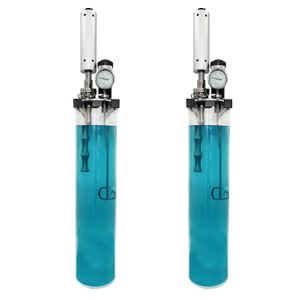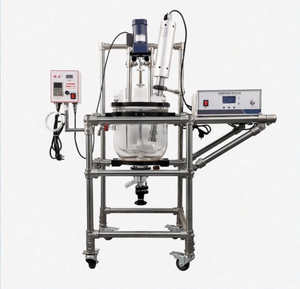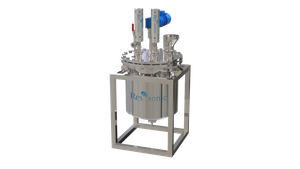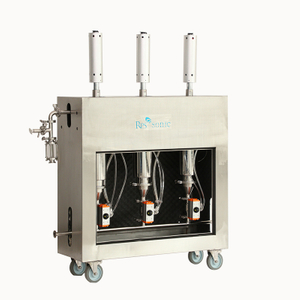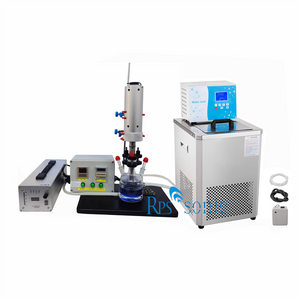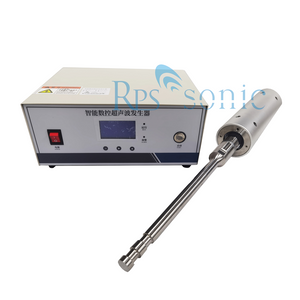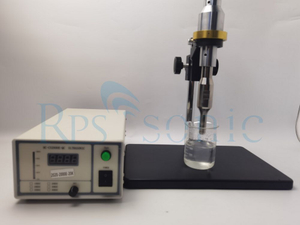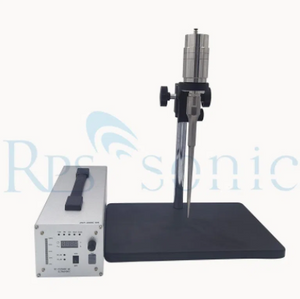Ultrasonic degassing and defoaming is an effective method for removing dissolved gases and or entraining bubbles from various liquids. Including water, candle wax, aluminum alloy melt, epoxy resins, silicone oils, adhesives, paint solutions, beverages, polymers, inks, paints, transformer oils, emulsion and suspension products, motor oils, and more. Unlike vacuum degassing, which is processed in batches, ultrasonic degassing can be performed in a continuous flow mode.
When a liquid is ultrasonic treated, sound waves propagating from the radiating surface into the liquid medium result in alternating cycles of high and low pressure at a rate that depends on the frequency. During the low pressure cycle, the ultrasound creates small vacuum bubbles or voids in the liquid. The large number of small bubbles produces a high total bubble surface area. Bubbles are also well distributed in the liquid. Dissolved gas migrates into these vacuum bubbles through the larger surface area and increases the size of the bubbles. Sound waves support the contact and coalescence of adjacent bubbles, resulting in accelerated bubble growth. Ultrasonic waves also help to shake the bubbles on the surface of the container and force the smaller bubbles located below the surface of the liquid to rise and release the trapped gas into the environment.
Ultrasonic equipment can effectively degassing and defoaming the liquid. In this case, ultrasonic waves remove small suspended bubbles from the liquid and reduce the level of dissolved gas below the natural equilibrium level.
Degassing and defoaming of liquids have many uses, such as:
Particle size measurement before sample preparation to avoid measurement errors.
Degassing of oil and lubricating oil before pumping reduces pump wear due to cavitation.
Degassing liquid foods, such as juice, soy sauce, or wine, to reduce microbial growth and extend shelf life.
When ultrasonic processing of liquid, sound waves propagating from the radiating surface to the liquid medium produce alternating cycles of high pressure (compression) and low pressure (thinning), the rate of which depends on the frequency. During the low-pressure cycle, high-intensity ultrasound creates small vacuum bubbles or voids in the liquid. A large number of small bubbles are evenly distributed in the liquid, resulting in more bubble surface area. The dissolved gas migrates into these vacuum (low pressure) bubbles through the larger surface area and increases the size of the bubbles.
Sound waves support the contact and merger of neighboring bubbles, thus accelerating the growth of bubbles. The sound waves will also help to detaches the bubbles from the surface of the container and force the smaller bubbles, which lie below the liquid surface, to rise and release the ensnared gas into the environment.
The degassing and defoaming process of the liquid is easy to see. In a glass beaker newly added to tap water, ultrasonic treatment will force small suspended bubbles to coalesce and move rapidly upward. You can see this effect in the progress image below.

Crude oil contains a lot of suspended bubbles. Especially in coolants, this is a problem because bubbles promote cavitation within the pump and nozzle, leading to wear. The progress chart below shows the effect of ultrasonic defoaming.

Even after letting the water sit for 24 hours, the ultrasonic treatment will create bubbles in the clean water. The gas migrates into bubbles, which are filled with dissolved gas. As a result, the bubbles grow and move upward. In any translucent liquid, the degassing effect is obvious.
Because ultrasound improves the rise of small suspended bubbles to the liquid surface, it also reduces the contact time between the bubbles and the liquid. Therefore, it also limits the redissolution of gases from bubbles to liquids. This is particularly relevant for high-viscosity liquids, such as oils or resins. Since the bubbles must move to the surface of the liquid, ultrasonic degassing is better if the container is shallow, so the time to the surface is shorter.
Gas influencing factors
The fluid contains a certain amount of dissolved gas. The gas concentration depends on factors such as temperature, ambient pressure, liquid agitation, etc. Ultrasonic degassing will change the conditions as the liquid is exposed to low pressure bubbles and agitation. Therefore, the ultrasonic wave will reduce the concentration of gas in the liquid below the original equilibrium level.
When the ultrasonic treatment is stopped and the initial conditions are re-established, the gas concentration will again slowly approach the initial equilibrium level unless the liquid is not exposed to any gas, such as in a closed bottle. Due to the slower rate of redissolution of gases in liquids, low-gas liquids can be used after ultrasonic treatment.

Degassing before emulsification and dispersion
Ultrasonic degassing can significantly improve the quality of dispersions and emulsions

Existing problem
Emulsions and dispersions usually contain surfactants to increase stability. The surfactant will inhibit contact and coalescence or condensation of the dispersed material in the liquid phase. To do this, a surfactant will form a cambium around each particle. Surfactants can also envelop bubbles suspended in the liquid phase. This stable bubble can prove to be very robust. It can consume surfactants, reduce the mass of emulsions or dispersions, and produce erratic readings when measuring particle size.
Solution
To reduce the problem of bubble stability, the liquid can be simply degassed by ultrasonic treatment. Before adding a dispersed phase, such as oil or powder, the liquid is ultrasonic treated until the number of bubbles produced is reduced. When mixing other materials, avoid creating new bubbles or vortices while stirring, which will rapidly increase the gas content.
Carbon dioxide detection
The effect of degassing is being used for leak testing of cans and bottles containing carbonated beverages such as cola, soda or beer.
Ultrasonic defoaming environmental protection low cost defoaming control system
Ultrasound equipment can be used to control foam in a number of different ways. The device can be used to suppress foam when foaming liquid is applied, and can also be used to break up existing foam that has already formed.
The technology is well suited for use in pharmaceuticals, beverages, chemicals and offers great cost saving options by:
Increase line speed for bottling and canning lines.
Reduce the damage caused by beverage spills.
Reduce scrap rates due to insufficient tank and bottle material.
It is biosafe due to less leakage and cleaning maintenance.
Cooling to 5 degrees Celsius before filling and raising the temperature back to 10 degrees Celsius after the bottling line is sent from the production line saves costs.

 English
English






